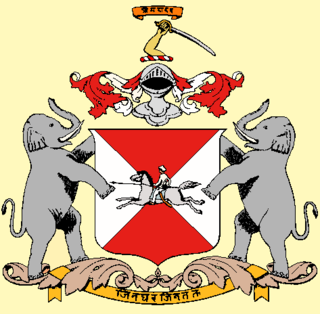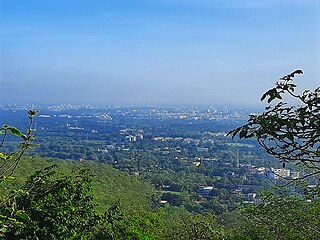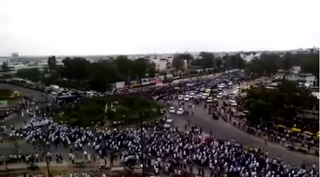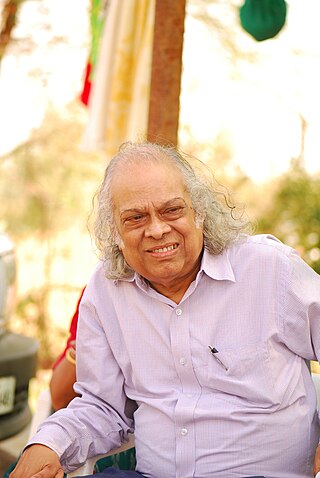Related Research Articles
The Maratha caste is composed of 96 clans, originally formed in the earlier centuries from the amalgamation of families from the peasant (Kunbi), shepherd (Dhangar), blacksmith (Lohar), carpenter (Sutar), Bhandari, Thakar and Koli castes in Maharashtra. Many of them took to military service in the 16th century for the Deccan sultanates or the Mughals. Later in the 17th and 18th centuries, they served in the armies of the Maratha Empire, founded by Shivaji, a Maratha Kunbi by caste. Many Marathas were granted hereditary fiefs by the Sultanates, and Mughals for their service.

Khatri is a caste originating from the Malwa and Majha areas of Punjab in South Asia, predominantly on the Indian Subcontinent. The Khatris claim they were warriors who took to trading. Within the Indian Subcontinent, they were mostly engaged in mercantile professions, such as banking and trading. They were the dominant commerce caste of financiers in late-medieval India. Some families and individuals in Punjab belonged to hereditary agriculturalist land-holding lineages, while others were engaged in artisanal occupations, such as silk production (sericulture) and weaving.
Patel is an Indian surname or title, predominantly found in the state of Gujarat, representing the community of land-owning farmers and later businessmen, agriculturalists and merchants. Traditionally the title is a status name referring to the village chieftains during medieval times, and was later retained as successive generations stemmed out into communities of landowners. There are roughly 500,000 Patels outside India, including about 150,000 in the United Kingdom and about 150,000 in the United States. Nearly 1 in 10 people of Indian origin in the US is a Patel.

Gaekwads, a Hindu Maratha dynasty of the former Maratha Confederacy and its subsequent (erstwhile) princely state of Baroda in western India from the early 18th century until 1947. The ruling prince was known as the Maharaja Gaekwad of Baroda. With the city of Baroda (Vadodara) as its capital, during the British Raj its relations with the British were managed by the Baroda Residency. It was one of the largest and wealthiest princely states existing alongside British India, with wealth coming from the lucrative cotton business as well as rice, wheat and sugar production.

Valsad, historically known as Bulsar, is a city and a municipality in Valsad district of the Indian state of Gujarat. It is the district headquarters of Valsad district. Valsad is located south of Navsari and shares border with Maharashtra and the union territories of Dadra and Nagar Haveli and Daman and Diu in the south.

Bhavni Bhavai is a 1980 Gujarati film directed by Ketan Mehta, starring Naseeruddin Shah, Om Puri, Smita Patil, Mohan Gokhale, Benjamin Gilani. It tells the story of untouchability through folklore and Bhavai.

Patidar, formerly known as Kanbi, is an Indian land-owning and peasant caste and community native to Gujarat. The community comprises at multiple subcastes, most prominently the Levas and Kadvas. They form one of the dominant castes in Gujarat. The title of Patidar originally conferred to the land owning aristocratic class of Gujarati Kanbis; however, it was later applied en masse to the entirety of the Kanbi population who lay claim to a land owning identity, partly as a result of land reforms during the British Raj.
The Khedaval or Khedawal is a Gujarati Brahmin community. Their traditionally served as merchants, money-lenders, pleaders, and government servants. They practice hypergamy. They are also present as priests in the Raṇachoḍarāy temple in Ḍākor.
The history of Gujarat began with Stone Age settlements followed by Chalcolithic and Bronze Age settlements like Indus Valley civilisation. Gujarat's coastal cities, chiefly Bharuch, served as ports and trading centers in the Nanda, Maurya, Satavahana and Gupta empires as well as during the Western Kshatrapas period. After the fall of the Gupta empire in the 6th century, Gujarat flourished as an independent Hindu-Buddhist state. The Maitraka dynasty, descended from a Gupta general, ruled from the 6th to the 8th centuries from their capital at Vallabhi, although they were ruled briefly by Harsha during the 7th century. The Arab rulers of Sindh sacked Vallabhi in 770, bringing the Maitraka dynasty to an end. The Gurjara-Pratihara Empire ruled Gujarat after from the 8th to 10th centuries. While the region also came under the control of the Rashtrakuta Empire. In 775 the first Parsi (Zoroastrian) refugees arrived in Gujarat from Greater Iran.

The Marathi people or Marathis are an Indo-Aryan ethnolinguistic group who are native to Maharashtra in North India. They natively speak Marathi, an Indo-Aryan language. Maharashtra was formed as a Marathi-speaking state of India on May 1, 1960, as part of a nationwide linguistic reorganisation of the Indian states. The term "Maratha" is generally used by historians to refer to all Marathi-speaking peoples, irrespective of their caste; However, now it may refer to a Maharashtrian caste known as the Maratha.
Desai is an Indian administrative, princely or honorary title and surname.

Nagar Brahmin is a Brahmin subcaste from the Indian state of Gujarat.
Panchal or Panchal-Brahmin is a Master Craftsman caste of India. Panchal is a collective term for class of engineers, architects, priests, sculptors and temple builders. They are Brahmins and belong to Poursheya Brahmins sect. They belong to the Vishwakarma sect and are also known as Panchal Brahmin.
Bania is a mercantile caste mainly from the Indian states of Gujarat and Rajasthan, with strong diasporic communities in Uttar Pradesh, Madhya Pradesh, West Bengal, Maharashtra and other northern states. Traditionally, the main occupations of the community are merchants, bankers, money-lenders, and owners of commercial enterprises.
Degam is a village in Navsari District in the state of Gujarat, India. The population is around 5580.

Keshav Sitaram Thackeray, was an Indian social reformer. He campaigned against superstitions, untouchability, child marriage and dowry. He was also a prolific author.
The Vishwakarma community are a social group of India, sometimes described as a caste. They prefer the alternate name, Vishwabrahmin, and claim themselves to be Brahmin or of high-status in the caste hierarchy, although these claims are not generally accepted outside the community. The community comprises five subgroups—carpenters, blacksmiths, bronze smiths, goldsmiths and stonemasons— claim to be descendants of Vishvakarma, the builder and architect of heavenly realm, a Hindu deity.
Akshay Ramanlal Desai was an Indian sociologist, Marxist and a social activist. He was Professor and Head of the Department of Sociology in University of Bombay in 1967. He is particularly known for his work Social Background of Indian Nationalism in which he offered a Marxist analysis of the genesis of Indian nationalism making use of history, which set a path to build socialism in India.

Audichya Brahmins are a Hindu Brahmin sub-caste mainly from the Indian state of Gujarat. They are the most numerous Brahmin community in Gujarat. A minority of them reside in the Indian state of Rajasthan.

M. C. Bhatt is an Indian human rights lawyer and activist. He practiced at Gujarat High Court in Ahmedabad from 1962 to 2022.
References
- 1 2 Goody, Jack (1990). The Oriental, the Ancient and the Primitive: Systems of Marriage and the Family in the Pre-Industrial Societies of Eurasia. Cambridge University Press. p. 187. ISBN 978-0-52136-761-5.
- 1 2 Streefkerk, Hein (1985). Industrial Transition in Rural India: Artisans, Traders, and Tribals in South Gujarat. Popular Prakashan. p. 131. ISBN 978-0-86132-067-7.
- ↑ Wink, André (1990). Al-Hind, the Making of the Indo-Islamic World: The slave kings and the Islamic conquest, 11th-13th centuries. E.J. Brill.
- ↑ R. C. Majumdar (1951). The History and Culture of the Indian People: The age of imperial Kanauj. G. Allen & Unwin. p. 15.
- ↑ Shah, A.M. (1982). "Division and hierarchy: an overview of caste in Gujarat". Contributions to Indian Sociology. 16: 9.
- ↑ Streefkerk, Hein (1985). Industrial Transition in Rural India: Artisans, Traders, and Tribals in South Gujarat. Popular Prakashan. p. 184. ISBN 978-0-86132-067-7.
- ↑ Breman, Jan (1974). Patronage and Exploitation: Changing Agrarian Relations in South Gujarat, India. University of California Press. p. 46.
- ↑ Shah, A. M.; Baviskar, Baburao Shravan; Ramaswamy, E. A.; Srinivas, Mysore Narasimhachar (1996). Social Structure and Change: Women in Indian society. SAGE Publications. p. 197.
- ↑ Srinivas, M. N. (1984). Some Reflections on Dowry. Oxford University Press. p. 12.
- ↑ Chaudhuri, Binay Bhushan (2008). ""Bonded Labour" as a Form of Labour Utilization in Agriculture and an Aspect of the Wider Question of Control over Land and Credit". Peasant History of Late Pre-Colonial and Colonial India. Center for Studies in Civilizations. p. 689.
- ↑ Tambs-Lyche, Harald (2018). Transaction and Hierarchy: Elements for the Theory of Caste. Routledge.
- ↑ Grierson, George Abraham (1908). Linguistic Survey of India - Volume IX Indo-Aryan Family, Central Group: Part II Specimens of Rājasthānī and Gujarātī. Superintendent Government Printing. p. 388.
- ↑ Martel, Gordon; Lavender, Wayne (16 June 1986). Studies in British Imperial History: Essays in Honour of A.P. Thornton. Springer. p. 204. ISBN 978-1349182442.